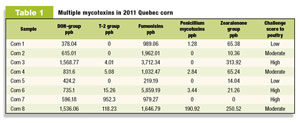So this year, a year of fairly intense heat in the eastern region of the nation, we have to ask ourselves the question: What does it and can it mean for us in the agriculture industry?
According to Dr. Swamy Haladi, global technical manager of the Alltech mycotoxin management team, intense heat and drought-like conditions not only cause obvious loss in crop yield but bring more mycotoxins to the farm as plants become stressed and more susceptible to diseases.
“It is not just excess rain that brings with it the increased mycotoxin challenge but, historically, the worst mycotoxin years are also drought years,” Haladi says.
Mycotoxins are harmful compounds produced by moulds (fungi) that are found in soil and can grow on vegetable matter including grain, forages and silages.
Mycotoxins can be formed in the field pre-harvest and may continue to be formed under suboptimal storage conditions postharvest.
Temperature is an important factor influencing mould growth and mycotoxin production and plants stressed by drought and high temperatures are commonly invaded by mould spores, which can produce mycotoxins.
Insect challenge in the field is directly proportional to temperature and such damage reduces the plant protection against moulds. The fact that some crop producers are not spraying fungicides to keep the cost down is not helping the cause.
“The global climate change has resulted in climatic extremes which are increasing the frequency of mycotoxin contamination we are seeing in our cereal grains, forages and silages,” Haladi says.
No matter what the cause, all the elements associated with drought are precursors for Aspergillus and some of the Fusarium moulds, such as Fusarium verticilloides and Fusarium moniliforme.
Aspergillius moulds produce Aflatoxin B1, the notorious carcinogen mycotoxin regulated by the FDA. Haladi recommends producers take field checks to look for grayish, yellow-green mould near the tips of or all over the ears. Producers should check in several areas of the field and not just one.
Even in places that may be used to seeing incidences of vomitoxin (DON) and zearalenone, Haladi warns that this year may be worse due to the dry conditions and insect damage.
Such conditions allow some Fusarium moulds to produce another group of mycotoxins called fumonisins. These toxins can compromise immune and gut systems at lower concentrations but cause pulmonary edema (fluid accumulation in lungs) at higher concentrations.
“Producers should positively identify any situations that may arise with this year’s corn crop and not assume it is the only Aspergillius,” Haladi says.
In order to identify more the risks associated with mycotoxins, Alltech recently launched its 37+ Program. The mass spectrometry technique LC-MS2 can investigate 38 different mycotoxins quantitatively and more than 50 others qualitatively in less than 15 minutes per sample analyzed, with limits of detection in the parts- per-trillion range.
A few weeks ago, this program came to the rescue in Quebec. Until then, fumonisins were assumed to be a problem in only climatic conditions as those exist in states such as Texas.
To ensure this was true, eight 2011 corn samples grown in different parts of Quebec were subjected to a 38-mycotoxin analysis.

As you can see in Table 1, five different groups of mycotoxins were detected in considerable concentrations.
Although other mycotoxins can be expected in Canadian conditions, fumonisins were not expected.
If we can see as high as nearly 6,000 ppb fumonisins in relatively cooler growing seasons of 2011, we can expect much higher concentrations this year due to dry conditions.
This is why a comprehensive testing program is critical for quality control of feeds and feed ingredients.
“Silage that is too dry, less than 65 percent moisture, will not pack well,” Haladi says. “This situation can increase the chances of Penicillum moulds making an appearance in our silage.
Unlike other mycotoxins, these silage mycotoxins can act as antibiotics and kill beneficial microbes in the rumen. The net result is lowered productivity.”
Haladi also warns if producers are cutting the silage lower to increase tonnage, they may also be increasing the amount of soil contamination and thus further increasing the amount of mould spores.
Once mycotoxins have made their way into the feed, there are still a few options available to the producer. They either should not feed the contaminated feed or should use an effective mycotoxin adsorbent.
There are two types of adsorbents: silica-based polymers and carbon-based organic polymers. Silica-type materials, such as clays, are readily available and many have shown to be effective against aflatoxins, but ineffective against other types.
Haladi recommends an organic mycotoxin-sequestering agent that can be used at practical levels of inclusion for all species of mycotoxins, including DON.
“Our livestock remains the best indicator of a mycotoxin presence,” Haladi says. “If an animal is not performing to its fullest or unexplained symptoms persist, consider the role that a mycotoxin may be playing.” PD
For more information on the Alltech Dairy Advantage series of natural solutions, click here to contact your local Alltech sales representative.

- Paul Groenewegen
- Canadian Technical Manager
- Alltech









